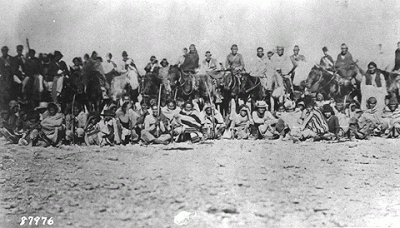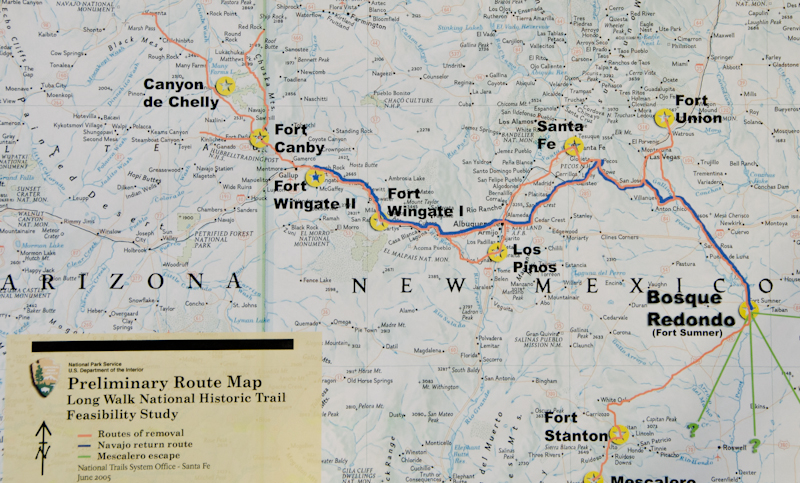.png) Cross-Link
Cross-Link
.png) PODCAST: The Navajo Nation's Own Trail of Tears, NPR (June 15, 2005)
PODCAST: The Navajo Nation's Own Trail of Tears, NPR (June 15, 2005)
Navajos on the Long Walk


A Brief overview of the Navajo conflicts with the United States from 1848 until 1868 when the Navajo were forcefully moved to a reservation called Bosque Redondo
What is known as "The Long Walk."
- Following the acquisition of Former Spanish lands such as Texas, New Mexico, Nevada, Colorado, Utah, Arizona, and California, after the Spanish American War in 1848, the Navajo people were now living in U.S. territory, which the U.S. intended on settling.
- The U.S. erected Fort Defiance in 1851 in what would become Arizona Territory.
- After soldiers killed Navajo livestock, Navajo Chiefs entered a period of launching attacks on the fort, and after 1000 Navajos almost overran the fort in 1860, the U.S. declared total war against the tribe.
- Led by Kit Carson, U.S. Soldiers drove the Navajo back to the Canyon de Chelly by use of a scorched earth tactic and forced thousands of surviving Navajos on a brutal journey to a reservation Called Bosque Redondo where they were forced to stay until 1868.

A look at the Bosque Redondo Memorial in New Mexico, here and also here

The Americans and the Navajo
Navajo Long Walk to Bosque Redondo
The Long Walk 1863-1866
- After the Navajo people surrendered to Kit Carson's scorched earth campaign, they were forced to leave their homeland
- - The Navajo were marched between 250 and 450 miles to the Bosque Redondo reservation, which served as an internment camp
- - They suffered enormous loss and horrific conditions: "When the people became exhausted, the soldiers became harsh, sometimes shooting prisoners rather than allowing the Navajo (Diné) to rest."
- - Over 10,000 people were forcibly removed from their ancestral homelands
- - Here, the Navajo were forced to participate in cultural assimilation (Civilization)
 Click here for a case study about the Long March and here for one on Bosque Redondo.
Click here for a case study about the Long March and here for one on Bosque Redondo.

Navajo women and children at Fort Sumner, Bosque Redondo era, New Mexico, ca. 1864–1868. Photograph from the Collection of John Gaw Meem, courtesy of Palace of the Governors Photo Archives (NMHM/DCA), 038207
 Why Was the Navajo Journey Home So Remarkable?
Why Was the Navajo Journey Home So Remarkable?
- Primary sources from the Long March for students to analyze and a teacher's guide from the National Museum of the American Indian

Kit Carson and Native Americans
Kit Carson Biography from The West from PBS
Kit Carson: Hero or Villain?
The Real Kit Carson Revealed
- Carson carried out a U.S. Army scorched-earth policy against the Navajo people.
- For more, see Blood and Thunder, An Epic of the American West, Hampton Sides (Doubleday, 2006).
Comments (0)
You don't have permission to comment on this page.